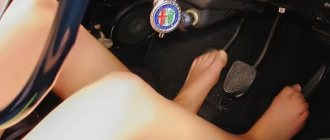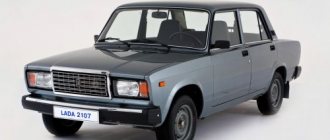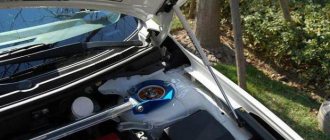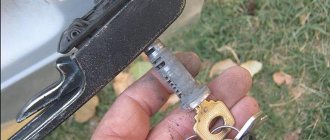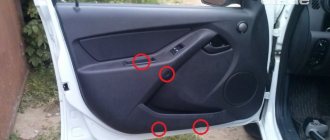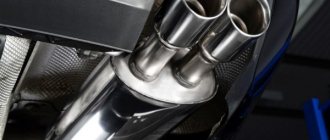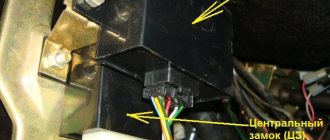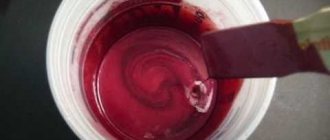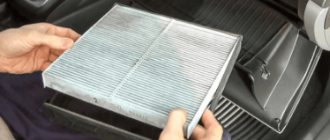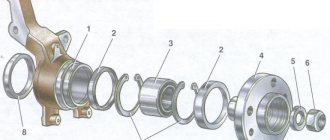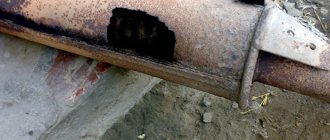Comments: no Published: 03/14/2016
Rating:
Tags:Dents on cars
Unfortunately, all elements of the external structure of the vehicle are not very durable, and therefore the question of how to straighten a dent on a car door is quite relevant.
Most motorists prefer to take their car in for repairs and entrust the restoration of external coatings to specialists. However, all straightening work can be done at home. This will require special equipment, skill in working with it, as well as suitable premises.
Removing a dent on a Mazda car door
Repairing damage to a car door with your own hands is attractive because you don’t have to wait several days for it to be repaired in a workshop, and also because you will spend a significantly smaller amount on such repairs. Most drivers, faced with the problem of dents on the front or rear door of their car, want to fix them so that painting is not required afterwards . This desire is absolutely justified, because painting will take additional time, materials and funds, and it is unlikely that you will be able to choose the same color that the car was painted in before.
However, it is worth considering the fact that straightening the door without subsequent painting is possible only in cases where the dent does not have strong chips and the paintwork remains undamaged.
Suction cup - a tool for removing dents on the body
Types of dents
A dent on a car door can be repaired both from the outside and from the inside. It all depends on the degree of damage, how much area it occupies and where it is localized. If the dent is small and shallow, then after removing it you won’t even need to paint the door.
Firecrackers
Car service technicians call crackers bruises that occupy a large area and have shallow depth. The area of damage can reach several decimeters with a depth of no more than 1 cm. At the same time, its edges are flat, and the thickness of the metal remains unchanged. Correction of the iron is accompanied by a sound similar to cotton, hence the name of the defect.
The main feature of a firecracker is its area - the larger it is, the easier it is to eliminate the concavity. This is not difficult to explain: the distance from the central part of the bruise to the edge is large. Sometimes it is enough to press the damage with your hand from the back of the door so that the metal falls into place.
It happens that in the place where the force is pressed there remains a hole of iron, then straightening is indispensable.
Medium dents
Such defects are much more difficult to correct, especially on the wings of a car, whose cavity is covered by spars. If there are no creases in the source of damage, and its edges are quite flat, heating and knocking out through a construction trowel will help. This tool serves as a worthy replacement for a professional ironer. Having a raised handle at the top, the trowel does not slide on the metal and does not interfere with straightening the defect with a hammer.
It is best to use a stainless steel trowel that has a polished bottom. This will help avoid scratches on the paint. During work, it is important to constantly degrease and wipe the working surface of the tool with a rag - the “sole” must be perfectly clean.
Small dents
A defect with a diameter of no more than 1.5 cm is considered small. It will not be possible to remove them with a hammer due to their small size. The only option to protect against such damage is to pull out the metal. It is done like this:
- Take a screw with a head/bolt having suitable shapes.
- The product is given the required shape using sandpaper and polished.
- The bolt head and working area are degreased.
- The bolt is glued using a glue gun, lubricating it on top for reliability. The thread allows you to attach something like an eyelet or handle.
- To pull out the metal, use a bolt, helping yourself with improvised means. They do this in several approaches, controlling the process.
- If the bolt comes off, glue it back on and continue the procedure of straightening the bruise to the desired state.
What dents can be fixed without painting?
The method for eliminating bruises on a car body depends on the location of the defect and the type of material on which it was formed. The same bruises formed on metal coating and on plastic are removed in different ways. For example, it is much more difficult to get rid of damage on an aluminum body than on a steel section. But steel is different - the metal of Japanese cars behaves differently, unlike the iron from which American and European cars are made.
Rules for straightening a dent
An ambulance can be provided to a car body that has been damaged by damage.
- A body panel made of sheet metal strains during deformation and then tries to restore its previous position. The master's task is to ease the tension.
- It is advisable to get rid of the dent immediately, since the damaged iron “remembers” its new position and its ductility decreases. If you leave a defect for a long time, even after straightening it may leave a trace.
- When a car door is dented, something like a small volcano forms. When working with damage, you should often tap the hills surrounding it, even if they are almost invisible. When repairing gentle dents in which the paint has not come off and there are no creases, the metal is straightened with the palm of your hand.
- Heated iron is easier to straighten, as its elasticity increases and the stress of the metal decreases. Heating is carried out with a construction hairdryer, constantly moving it over the entire area of the defect at a distance of 10 cm from the surface. One condition: you can’t stay in one place for a long time - the paint can bubble and peel off from strong heat.
How to remove small dents on a car body yourself
The most correct thing to do in case of such damage is to contact a service center. However, due to insufficient funds or the inability to carry out such repairs from the “officials”, it is quite possible to eliminate the defects yourself, especially if your car was “injured” not on the edge of the metal, edges and edges of body parts. Moreover, if the dent occurs in a place that is easily accessible for repair, the damage can be removed in just a few minutes. Let's see how this can be done.
Removing dents with a magnet
If the resulting depressions on the body are not very deep - no more than five to seven millimeters - the most effective way to level the body surface is to use a magnet. Powerful neodymium search magnets (made from an alloy of neodymium, iron and boron. With the help of such devices with an attractive pull force of 200 to 600 kg, metal objects that have fallen into the water or lost in a garage or warehouse are searched for) are best suited for the role of a “retractor.” . When performing the retraction operation, several rules must be followed.
First of all, you cannot attach a neodymium or search magnet directly to the body. You need to apply a magnet to the dent through a thick cloth to weaken the effect of the magnetic force (especially necessary when you are using a very powerful magnet). Then the magnet is shifted through the lining from the edge to the center of the dent while simultaneously pulling the magnet towards itself. Before you try this technology on your car, we recommend practicing on deformed pieces of iron. When working with neodymium magnets, precautions should be taken. At a minimum, don’t be lazy to wear thick protective gloves.
Removing dents with vacuum suction cups (vacuum straightening)
When working with vacuum suction cups, you do not need any additional equipment or materials, but you should take the trouble to purchase the right tool. By the way, you should look for it in specialized automobile stores. Many professional suction cups are sold complete with a set of rubber attachments of different sizes. The effectiveness of the job directly depends on how well the tool was fitted to the specific dent. For optimal results and to avoid subsequent painting, make sure that the diameter of the suction cup is slightly smaller than the size of the dent.
In this case, the edges of the suction cup must fit tightly to the metal, otherwise creating a vacuum clutch will be difficult. In other words, defects with complex bends or chips will be difficult to eliminate using this method. Before attaching the suction cup, the damaged sector should be washed and dried, and if necessary, remove stubborn dirt or rust.
After attaching the suction cup, pump out the air from the resulting cavity. This process is carried out differently in different models of suction cups. After this, you can begin to actually pull out the dent. To do this, you need to pull the suction cup handle in the desired direction. Usually muscle power is enough, but sometimes you can use the traction of other vehicles. At the final stage, air is introduced into the cavity between the body and the suction cup in order to detach the “puller” from the body.
Removing dents with a hairdryer
This method is based on the physical property of metal to straighten under the influence of temperature differences. At the first stage, we warm up the area of the dent with a regular hair dryer, making sure that the surface of the body does not overheat. You can also use a more powerful hair dryer, but be careful not to overheat the repair area. In all cases, the device should be kept at a distance of no more than 15 cm from the surface of the body, capturing the metal areas around the dent.
Alternatively, you can also heat the surface of the dent with boiling water. Once the surface is warm, immediately spray it with air freshener, deodorant, or a can of compressed air. Spray the spray for a long time until frost appears. Instead of a spray, you can use a bag of dry ice (solid carbon dioxide CO2, used mainly to cool food during transportation and storage), having previously insulated the heated area of the metal with foil. In all cases, a few seconds after the cooling process, a pop occurs and the dent is straightened out. If the dent has not straightened completely, but has only become smaller, the procedure must be repeated. However, it is recommended to do this no earlier than a day later.
Removing dents with hot glue
When using this technology, the dent is first cleaned and degreased, then heated with a hairdryer. Then, using a heat gun, glue is applied to a special plastic mushroom (polymer adapter), which is immediately glued to the center of the dent. After waiting from one to five minutes, the fungus is pulled out with a mini-lifter for pulling out dents (a special device with an adjusting screw, a rubberized support and a grip for adapters (glue pins or fungi).
You can purchase such a device in specialized stores. After straightening the dent, you will need to detach the fungus from the body. To do this, the repaired surface should be thoroughly wiped with alcohol, gasoline, acetone or white spirit, but it is better to use specialized cleaners, which are available in automotive and hardware stores.
And the well-known portal “Garage 54” recently demonstrated how you can effectively straighten even a very large dent using a blowtorch and glue sticks for hot-melt guns. This technology is outrageously simple. First, a bundle of glue rods is melted with a blowtorch, the molten tip of the bundle is then pressed against the center of the dent for several minutes, after which the bundle is sharply pulled towards itself until it is torn away from the body. After several repetitions of this procedure, it is possible to almost completely eliminate the dent. In this case, there are practically no traces of “burns” and dirt on the body.
Removing dents using levers and hooks
For this procedure, you should purchase a set of special levers and hooks from an automotive store. This tool comes in various shapes and lengths. As a rule, the working parts of levers and hooks are bent at different angles. Repairs must be carried out from the inside of the body. Accordingly, the casing and external elements that impede straightening are first dismantled. Before straightening the dent, the work surface is cleaned. Then the repair site is heated with a construction hairdryer to 40-50 degrees. Then a lever of the required length and configuration is selected based on the location of the specific dent.
The device is applied to the inside of the dent (often the repair area is reached through one or another technological hole), after which the metal is gradually straightened by smooth scrolling and pressing on the damaged area.
In some cases, it may be useful to place something hard on the inside of the dent to increase the area and reduce the intensity of the pressure. Professional kits contain special polymer wedges that are placed under the metal of the hook or lever so as not to deform the car elements. Let's make a reservation that the last method requires quite a lot of skills. Therefore, if you do not have enough experience working with levers, it makes sense to practice on old parts or pieces of metal.
5 dangerous mistakes when changing and adding engine oil:
Heating and subsequent cooling for repairs
Hot metal is ductile and pliable, but to eliminate bruises, some nuances are observed. So, how to remove dents on a car door with your own hands by heating step by step:
- The trick to heating a concave surface is that after heating it is immediately cooled. When cooled, the iron shrinks, the metal's tension decreases, and the bruise straightens out with a peculiar sound.
- Heating is suitable for shallow defects with a large area. The dented area is heated with a hair dryer or the car is left for a long time under the scorching sun. For quick cooling, use dry ice or a Dust off can to blow off dust from the computer.
- Before heating, wash the dent and the area around it with soapy water - a clean surface will heat up faster.
- The metal must be heated so that the metal is hot in the center of the concavity and cold at the edges. If the entire dent is cooled, the method will not work.
- The heating method is applicable only to defects on metal; it does not work on plastic.
- If the iron does not fall into place the first time, you should repeat the heating and cooling again.
Using a Hot Glue Gun and Pull Tools
- The idea is to glue the pulling elements to the dent in several places. By pulling them, you can straighten out the dent. The house-to-house method is used in the PDR technology adhesive system.
- The pulling element can be made by simply screwing two self-tapping screws on one side of a wooden dowel, and applying hot glue to the reverse side (bottom). Such dowels can be placed in several places. After the glue has cooled and hardened, you can pull the pulling elements. You need to prepare a sufficient amount of glue and be patient, as you may need to make several attempts.
- For small dents, the pulling element can be glued to the center. Large dents extend from the edges.
- This way you can pull out the jammed stiffening rib, which “holds” the entire dent.
- At the same time, when pulling out dents, you need to tap the high spots, if any.
- To remove the pulling element, heat the glue with a hairdryer. Use isopropyl alcohol to loosen and remove the adhesive.
The next available option for using hot glue to fix dents is to use a plastic bottle with a cap. Glue is applied to the bottle cap, the cap is pressed against the dent without much pressure, held until the glue cools, then you can pull the bottle, pulling out the dent. The bottle is light in weight and does not peel off the glue prematurely, and is also comfortable for your hands to grip when pulling. If the dent is large, then you can use several covers, according to the same principle as in the method described above with dowels and screws. The covers are glued along the inner edges of the large dent. For pulling, you can use just one bottle, alternately screwing it to different caps. After most of the dent has been pulled out, the remaining indentations can be pulled out by gluing the cover directly into the center of the small dent.
An even more affordable option for using hot glue to pull out dents is to use glue sticks directly. That is, the rods themselves will pull out the dent. The advantage of this method is that you don’t even need a glue gun to glue the rods; the ends of the rods can be heated with a simple lighter. Several rods may be required, depending on the size of the dent and its configuration. For example, a long dent can be pulled out by gluing a series of rods along its bottom. A large smooth dent (without creases) can be straightened by gluing a whole bunch of rods. After pulling out the main part of the dent, the remaining indentations can be pulled out by gluing a glue stick directly into the center of the small dent.
In all methods of straightening dents using hot glue, adhesive residues are easily removed with alcohol. The limitation of these methods is the strength of the paint coating. It is better that the panel where the dent extends has not previously been repaired and repainted. In the worst case, the paint may peel off when pulled. In most cases, the method is quite safe and works quite well.
Pulling out a dent with a reverse hammer
You can make a reverse hammer to straighten out dents. To do this, you need a rod 3–5 mm thick and a piece of pipe. You can use hot glue to glue one piece of the hammer to the center of the dent. The principle is the same as when using pulling elements, only the hammer adds additional force through the inertia of the sliding load.
You can make a reverse hammer yourself.
In the illustration you can see the basic concept of the reverse action hammer. You need to pull out the dent before the glue hardens too much. Because when the glue hardens, it becomes brittle and comes off the surface prematurely when pulled out. You need to apply glue, press the rod onto it and wait for it to cool, after which you begin to slide part of the pipe (weight) along the rod. A reverse hammer is convenient for straightening small and medium-sized dents.
Using a Dent Pulling Kit
This kit also uses hot glue to secure the puller to the dent. The places where the pulling device will be glued must be degreased with isopropyl alcohol. You need to use a little glue.
You need to apply pulling pressure with the device and leave it for 5 minutes, periodically heating the edges of the dent. In general, when pulling with a special device (small bridge), the slow method works better than quickly pulling out the dent. Gradually reducing the size of the dent, you can do several repetitions. If there are raised areas around the dent, they must be carefully tapped with a special punch, which is included in the kit. You can read more about using the kit for straightening dents in the article “Pops A Dent kit, instructions on how to use it correctly.”
Method for straightening dents using a vacuum cleaner
For the option with a vacuum cleaner, you will need a minimum of available items:
- household vacuum cleaner with high power;
- bucket/flower pot;
- soapy water;
- sponge;
- towel;
- masking tape/adhesive tape.
Then everything is simple:
- Wash and wipe dry the areas where the tape will be placed.
- Make a hole in the bottom of the pot.
- Completely cover the dent with a bucket or flower pot and secure with tape.
- Turn on the vacuum cleaner, attach the hose to the hole in the planter and press.
- If possible, ask an assistant to press on the dent from the inside - this will make it easier for the vacuum cleaner to cope with the task.
Method for straightening dents using a ball
An effective method for straightening a car door with your own hands is to use a regular rubber ball with a pump.
- Deflate the air from the ball and place it inside the panel between the stop object and the dent.
- Place a piece of cloth under the ball and start pumping it slowly.
- Do not overdo it, otherwise you may deform the metal. Once the iron is in place, deflate the ball and remove it.
For best results, heat the outside of the dent with a hairdryer.
Correcting a dent using the back of the panel
The most obvious method for straightening a dent can be considered from the back side of the panel. You need to provide access from the back of the damaged panel, and press with your hand or the handle of a hammer or screwdriver wrapped in a rag into the middle of the dent on the back of the panel. Additionally, you can first heat the edges of the dent, thereby reducing the stress on the metal. If the dent has a large diameter, then you need to straighten it from the edges to the center, pressing and smoothing it in a spiral. We will look at another method, which also requires access from the reverse side, at the end of this article.
Removing door dents using hooks and levers
They resort to levers and hooks when there is no time/desire to remove the door and its trim from the inside.
- To align the door, purchase a set of these tools in a specialty store at a low price, mark all visible defects.
- Select a tool for each concavity, and then insert the hook into the technical hole of the car door.
- Having felt the damage with a hook, press firmly on it, pushing the metal in the desired direction.
- From the outside, you can press down the dented iron a little so that it does not bend too much in the opposite direction.
Pulling out a dent with a plumber's plunger
This device can not only clear the blockage, but also pull out the dent. You should use a sink plunger, not one designed for cleaning toilets. This is a more affordable version of a special suction cup, which is used in paintless dent repair.
After pulling out the dent with a plunger, small irregularities may remain that require subsequent leveling.
It is necessary to moisten both the surface of the panel with the dent and the plunger itself, more precisely, its rubber part. You can use hot water. Hot water will make the rubber of the plunger more elastic and also warm the surface a little. You need to install the rubber valve on the dent, press and pull sharply. Smooth dents without strong creases can be pulled out in this way. There may be no trace left, or there may be a slight crease in the metal.
Repairing dents with a jack
The jack is used for complex, large metal damage, especially on the wings. The main thing is to choose the right size of the device. Let's look at how to fix a dent on a car fender using a jack:
- make a free approach to the bruise from the inside of the wing;
- firmly fix the jack opposite the defect on the wing;
- for reliability, use a pair of wooden blocks with leveled surfaces - place one under
- “sole” of the jack, place the second one directly under the deformed wing;
- slowly work with the jack until you can level out the dent;
- pull out the bars, remove the jack.
Removing dents on a car using a reverse hammer
The reverse hammer method is effective when there is no chance of reaching deformed parts of the body or their dismantling is impossible. How to level a car door with a hammer:
- Wash and dry the dented part of the body.
- Fix one end of the hammer firmly in the center of the defect using a suction cup.
- Begin to lightly hit the handle of the reverse hammer with a weight that gradually moves along the metal along the concavity.
- After restoring the iron to its original place, unfasten the hammer from the car body.
Before attempting to repair dents on a car yourself, it is recommended to practice on old, unnecessary body parts, if any. The main thing in pulling is not to go too far, otherwise you can squeeze out the metal too much and then you definitely won’t be able to do it without specialists and painting. By the way, the average price for repairing small dents without applying paint is about 700 rubles, front door - 4000, rear door - 5500, trunk - 4500.
Replacing a part or part of it
If there is more serious damage, removing dents will not help restore the integrity of the part. In this case, the body element, or its most severely damaged part, is replaced with a new one. When replacing, it is necessary to find a part identical to the one being replaced. If a specific area is being replaced, the patch is cut from the same metal. Next, it is welded to the part being restored.
Minor damage to the body, chips, scratches and dents on the car can be repaired independently without repainting. Parts of the body that were not previously damaged are subject to restoration. If paint cracking, breaks or kinks appear, repairs without painting will not be possible.

